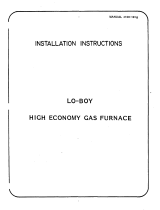
18
6. For Honeywell gas valves with the regulator converter:
a. Unscrew the pressure regulator cap and check for
the letters NAT or LP. See Figure 27 (page 17).
b. Invert the cap and tighten until snug.
7. For Robertshaw gas valves with the regulator converter:
a. Remove the black cover and unscrew the converter
located on top of the gas valve. See Figure 28 (page
17).
b. Invert the converter. For LP, the red ring will be located
at the bottom and the LP stamping on the converter
will appear right side up.
c. Screw converter back into the regulator, hand tight
plus 1/8 turn. Replace the black cover on the converter
top to protect the threads.
8. Reassemble the burner assembly into the furnace.
9. Reconnect the gas piping and electrical wires to the
gas valve.
10. Open the manual shut-off valve and follow the M1M
Operating Instructions on page 20
Measuring the Supply Gas Pressure
To obtain an accurate pressure reading, turn off all
gas appliances (i.e. Dryers, water heaters, stoves,
etc.) at their ON/OFF control or individual gas valves.
1. Remove the inlet pressure plug from the INLET side
of the gas valve with a 3/16 Allen wrench. See Figure
27 (page 17).
2. Install a 1/8 NPT fitting, which is compatible with a
manometer or similar pressure gauge.
3. Connect the manometer or pressure gauge to the inlet
pressure tap.
4. Turn on all electrical power to the furnace.
5. Turn the main gas supply valve (on the outside of the
unit) to the ON position.
6. Start the furnace by adjusting the thermostat to it’s
highest setting. Allow the furnace to run for 10 minutes.
7. Check the incoming gas line pressure. Propane gas
furnaces must be between 11.0”-14.0” W.C. Natural
gas installations must be between 4.5”-10.0” W.C. If
the pressure is not between these specified ranges,
contact your local gas supplier for adjustment.
8. Adjust the thermostat to it’s lowest setting and allow
the unit to cycle off.
9. Turn the main gas supply valve (on the outside of the
unit) to the OFF position.
10. Turn off all electrical power to the furnace.
11. Disconnect the manometer or pressure gauge.
12. Remove the NPT fitting and reinstall the inlet pressure
plug. NOTE: To prevent cross threading, hand tighten
the plug first, then tighten with 3/16 Allen wrench.
Measuring the Manifold Pressure
The manifold pressure must be measured by installing a
pressure gauge (Manometer, Magnehelic Meter, etc.) to
the outlet end of the gas valve.
1. Remove the manifold pressure plug from the outlet side
of the gas valve with a 3/16 Allen wrench.See Figure
27 (page 17).
2. Install a 1/8 NPT fitting, which is compatible with a
Manometer or similar pressure gauge.
3. Connect the manometer or pressure gauge to the pipe
thread fitting.
4. Start the furnace by adjusting the thermostat 5 degrees
above room temperature. Allow the furnace to operate
for 3 minutes.
5. Measure the manifold pressure on the manometer or
pressure gauge. Compare the measured value to the
value in Table 15, (page 30), Table 16, (page 30),
or Table 17, (page 30).
6. Replace the cap so that the letters facing up represent
the type of gas being used for the furnace. See Figure
27 (page 17).
7. Adjust the thermostat to its lowest setting.
8. Turn off the main gas supply to the unit at the manual
shut-off valve, which is located outside of the unit.
9. Turn off all of the electrical power to the furnace.
10. Disconnect the manometer or pressure gauge.
11. Remove the 1/8 NPT fitting and reinstall the manifold
pressure plug. NOTE: To prevent cross threading,
hand tighten the plug first then tighten with 3/16 Allen
wrench.
Oil Tank & Piping Installation
The following procedures are recommended as good
practice. However, requirements of local codes and
ordinances, H.U.D. Manufactured Home and Safety
Standards or National Fire Protection Association must be
satisfied, where they apply, for an approved installation.
• Use a tank capacity suitable for the application with a
weatherproof, capped fill opening and a shielded vent
to let in air as fuel is used.
• The inside of the tank must be clean before filling. All
water, rust, sediment, and debris must be flushed out.
• A fuel or tank gauge is recommended for easy checking
of the fuel level. Check the gauge reading with a dipstick.
See Figure 29 (page 19).
• Locate the storage tank conveniently near the home.
If the fuel tank is installed above ground, the tank may
rest 3 to 4 inches off the ground. Fuel tanks may also
be buried if properly coated to resist corrosion. The
vertical dimension from the bottom of the fuel tank to
the fuel pump must not exceed 10 feet.
• Keep the tank filled, especially in the summer to reduce
the accumulation of condensation.
One-Line System
The One-Line System is highly recommended where
vertical lift, from bottom of tank to pump, is less than 8
feet. See Figure 29 (page 19). A single line hookup
has the advantage of lower cost and quieter operation.
Two-Line System
If a Two-Line system is used or if oil is taken from the
bottom of the tank, a filter is recommended. A Two-Line
system should only be used if vertical lift exceeds 8 feet.
1. Install the oil feed line as outlined in steps 1 - 6 below.
2. Install the oil pump bypass plug in the bottom return
port.
3. Route the return line up through the furnace base to
the return port of the pump. Route the other end of the
line to the tank, using 3/8” O.D. copper tubing or 1/4”
pipe with the ends capped.




















